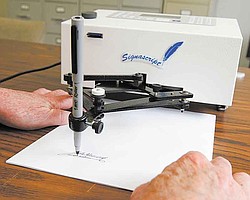Barack Obama’s signature: Real or autopenned?
ASSOCIATED PRESS
In this photo taken June 13, 2011, Damilic Corp. president Bob Olding anchors the paper as the Atlantic Plus, the Signascript tabletop model autopen, produces a signature at their Rockville, Md., office. Damilic Corp. is the leading manufacturer of automatic signing machines for replicating authentic signatures. Autopens have been used for decades by presidents of both parties, an open secret nobody in Washington wants to talk about, including the White House. (AP Photo/Manuel Balce Ceneta)
Associated Press
WASHINGTON
It’s the open secret that nobody in government wants to talk about: That cherished presidential signature that’s tucked away in a scrapbook or framed for all to see might never have passed under the president’s hand.
For decades, presidents of both parties have let an autopen do some of the heavy lifting when it comes to scrawling their signatures. The machine recently was put to use signing a bill into law, apparently a first.
Overseas and out of reach when lawmakers passed an extension of certain provisions of the Patriot Act, President Barack Obama employed the autopen to sign it, a step the White House has been mum about ever since.
Jim Cicconi, who oversaw the use of autopens for President George H.W. Bush, recalls that the plastic signature templates for the machines — yes, there was more than one autopen — would wear out from repeated use.
Ronald Reagan had 22 different signature templates, including “Ron,” “Dutch” and other iterations, to boost the aura of authenticity surrounding his fake signatures, says Stephen Koschal, an autograph authenticator who two years ago published a guide to presidential autopen signatures.
Obama’s staff is loath to talk about his use of the autopen.
The president prefers to keep the focus on the sampling of 10 letters a day that he reads from among the tens of thousands that ordinary people send to the White House. In many cases, he writes back to these people with his own signature.
But the president couldn’t get around explaining how the Patriot Act got signed into law without briefly shining a spotlight on the autopen. Once that news was out, though, the White House clammed up.
And don’t ask Bob Olding, whose company is the leading manufacturer of autopens, to discuss his clientele.
“I’m not going to help you,” he said. “Our customers do not want anyone else knowing they have these machines.”
Olding did reveal, though, that “when there’s a major change in government, we get an uptick in business.”
Olding is president of Rockville, Md.-based Damilic Corp., whose signature machines run from $2,000 up to $10,000. Hulking older versions look like a drafting table and are too big to fit through a doorway.
Newer models, with microprocessors and digital controls, sit on a tabletop. But they still feature two mechanical arms that move a pen back and forth, up and down.
The machines sign letters at about the same pace as does the human hand. An autopen machine that automatically signs a stack of documents can spit out roughly 500 signatures an hour; those with manual document feeders, about 200 an hour.
Autopens have been used by presidents since Dwight Eisenhower, says Koschal, and President John F. Kennedy put them to heavy use. Many presidents have had secretaries sign their names to correspondence and documents, he says.
 43
43

